Bust of Septimius Severus wearing a cuirass
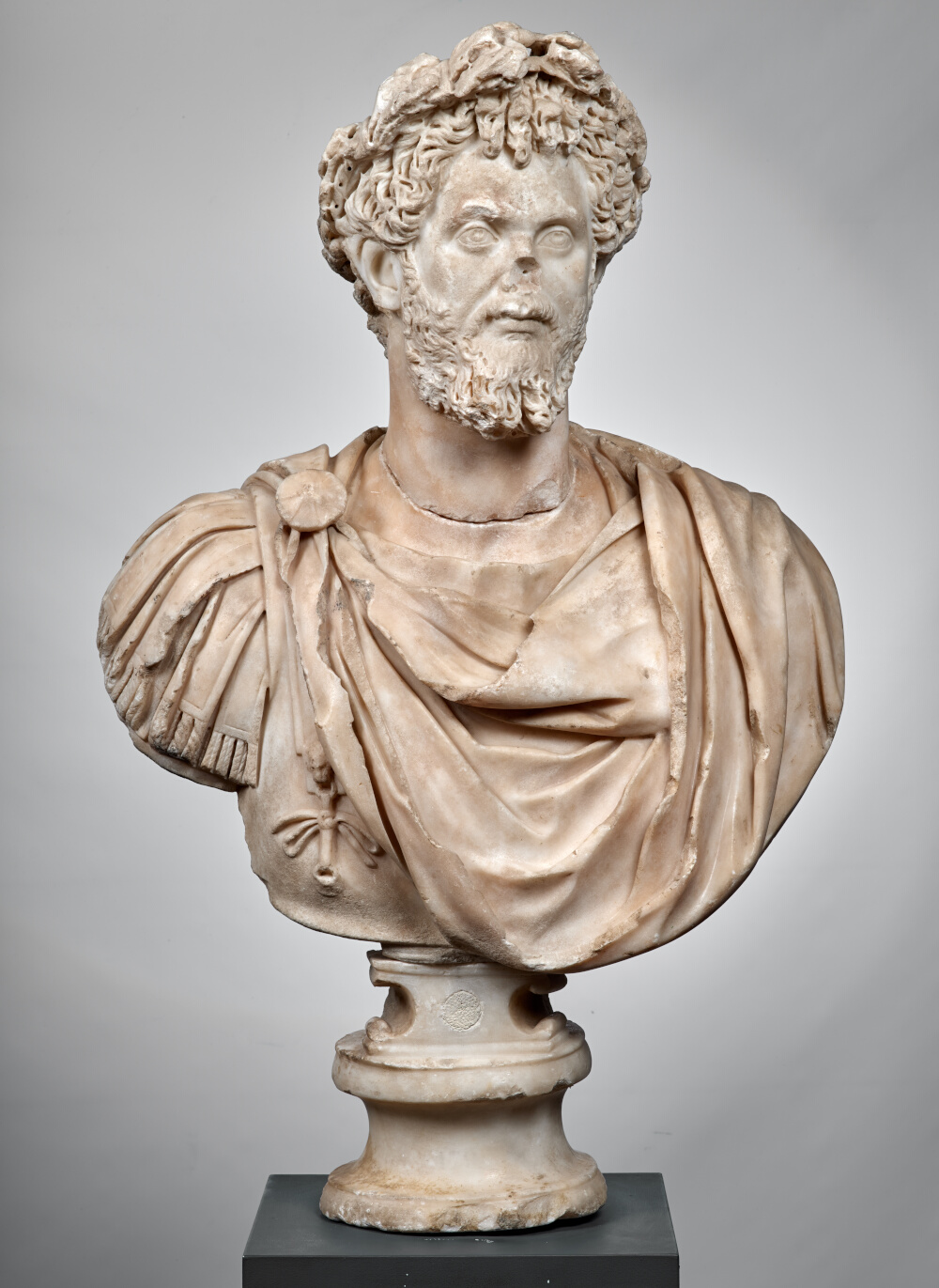
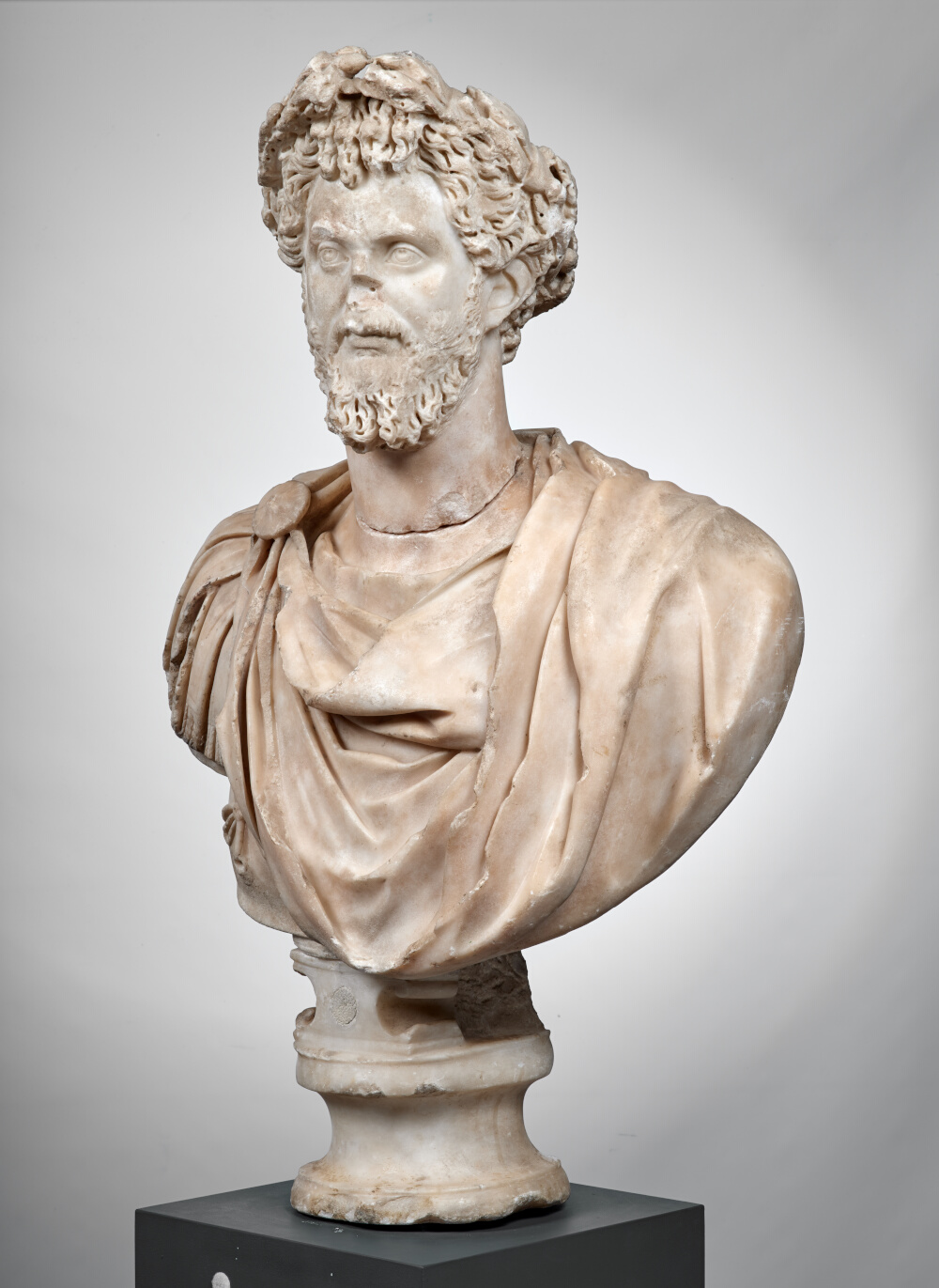
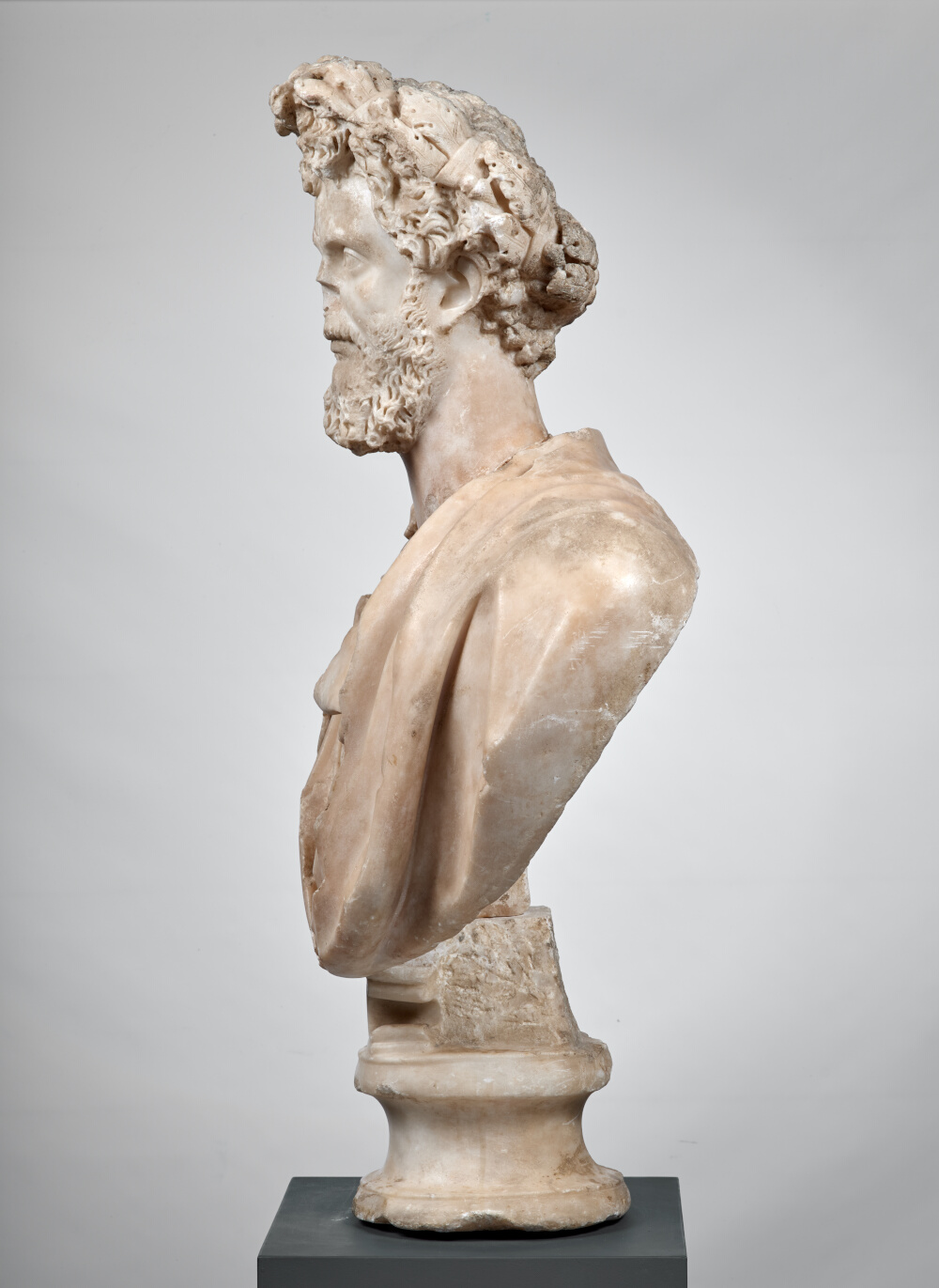
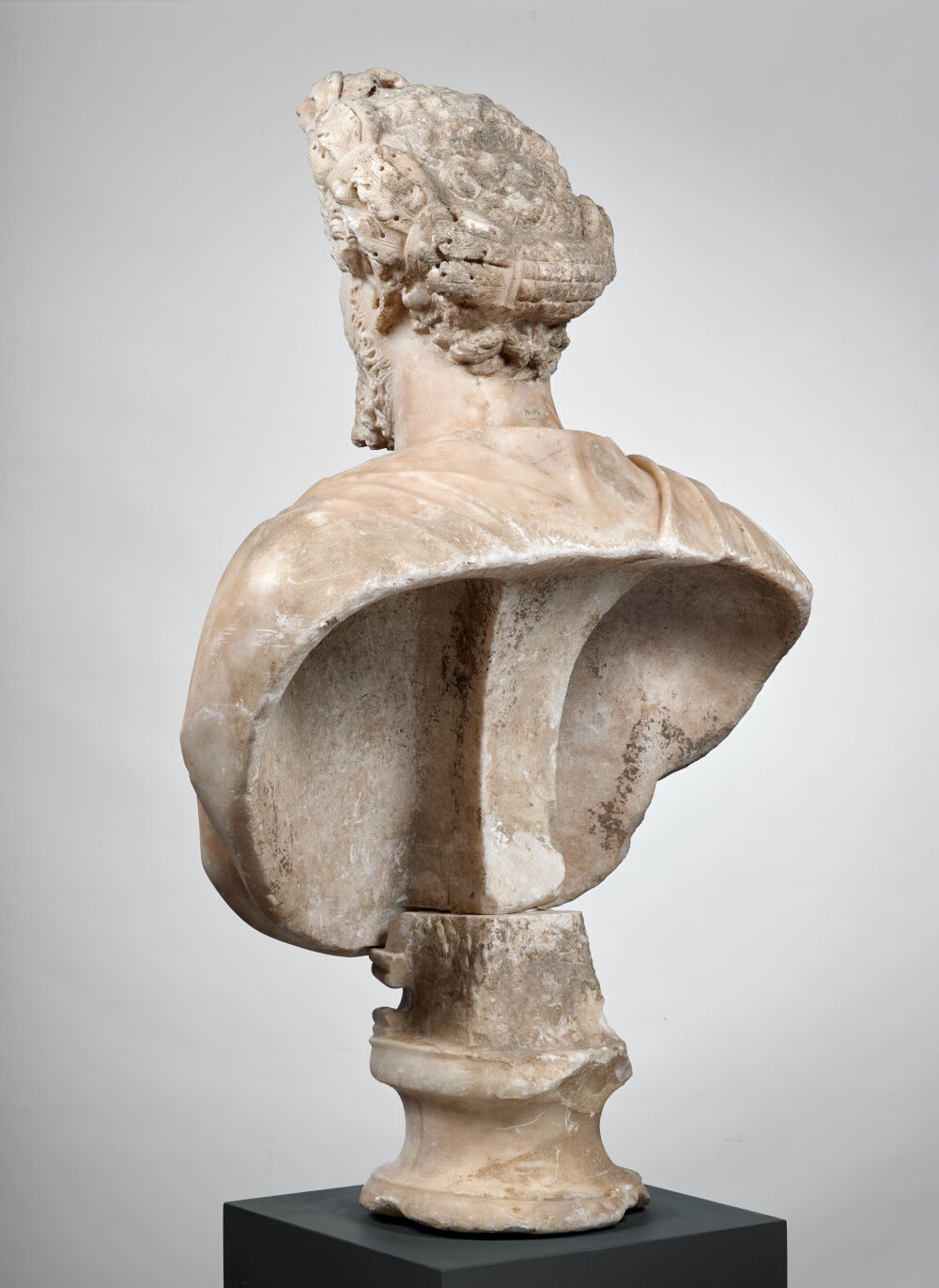
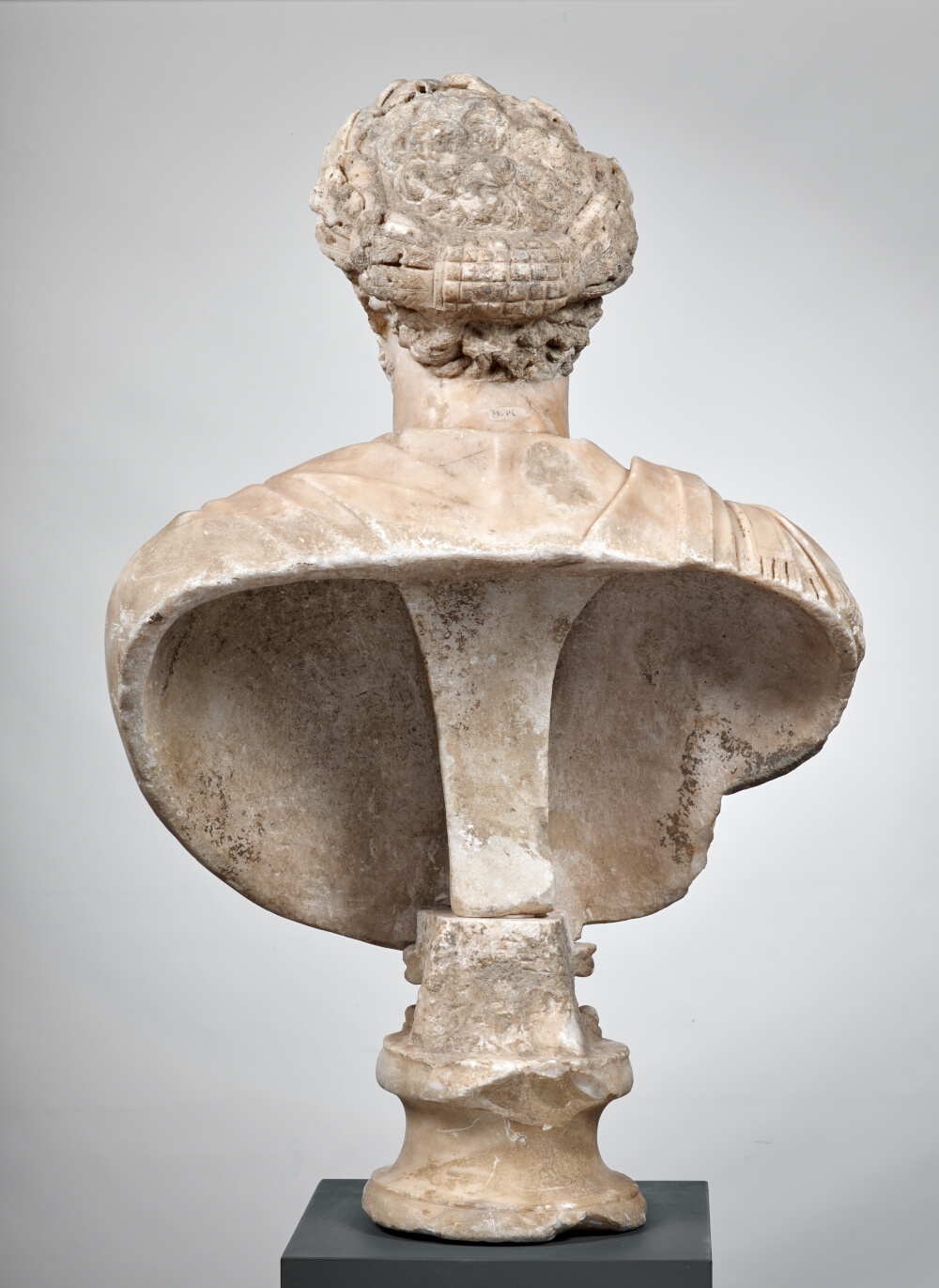
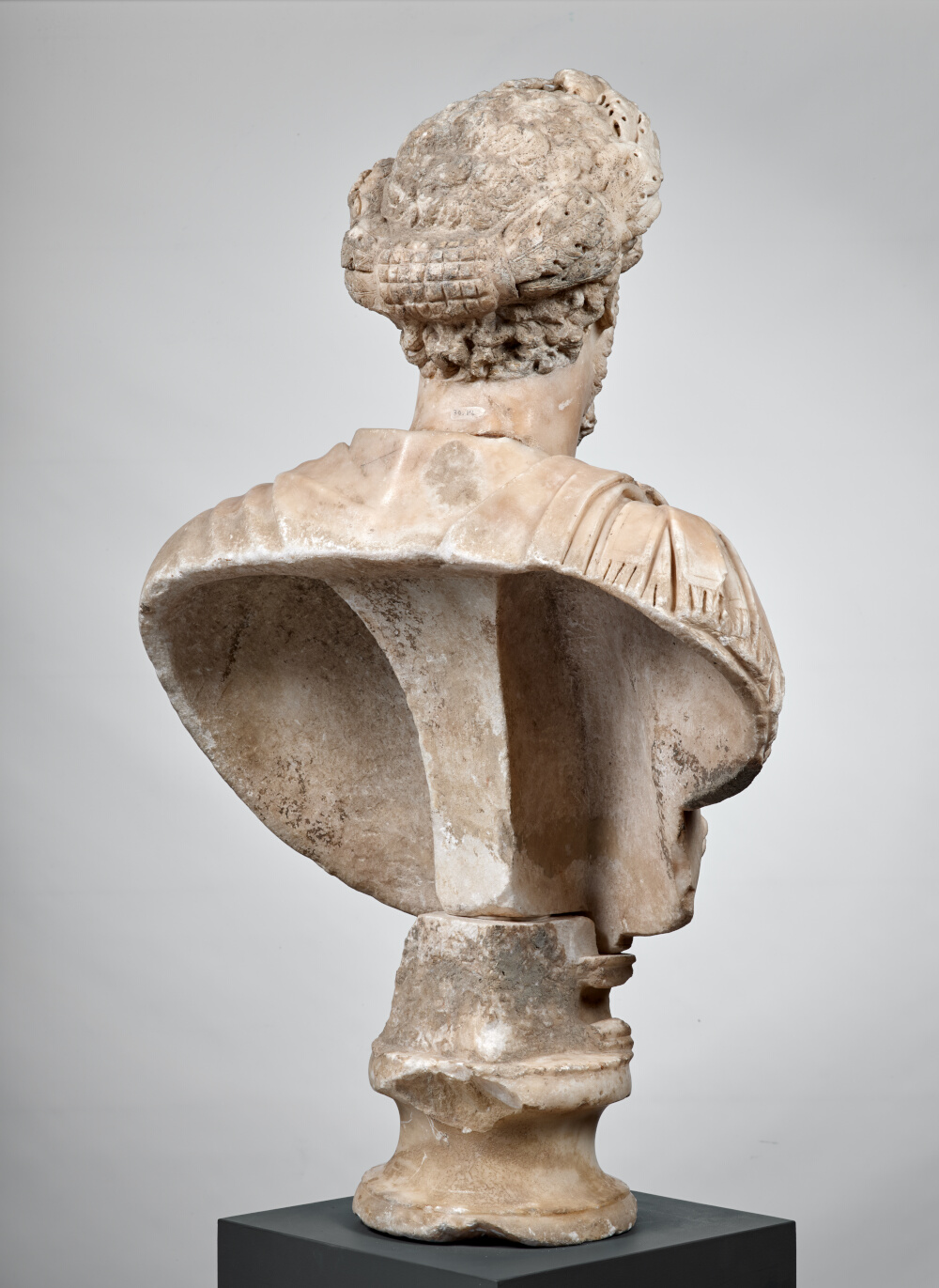
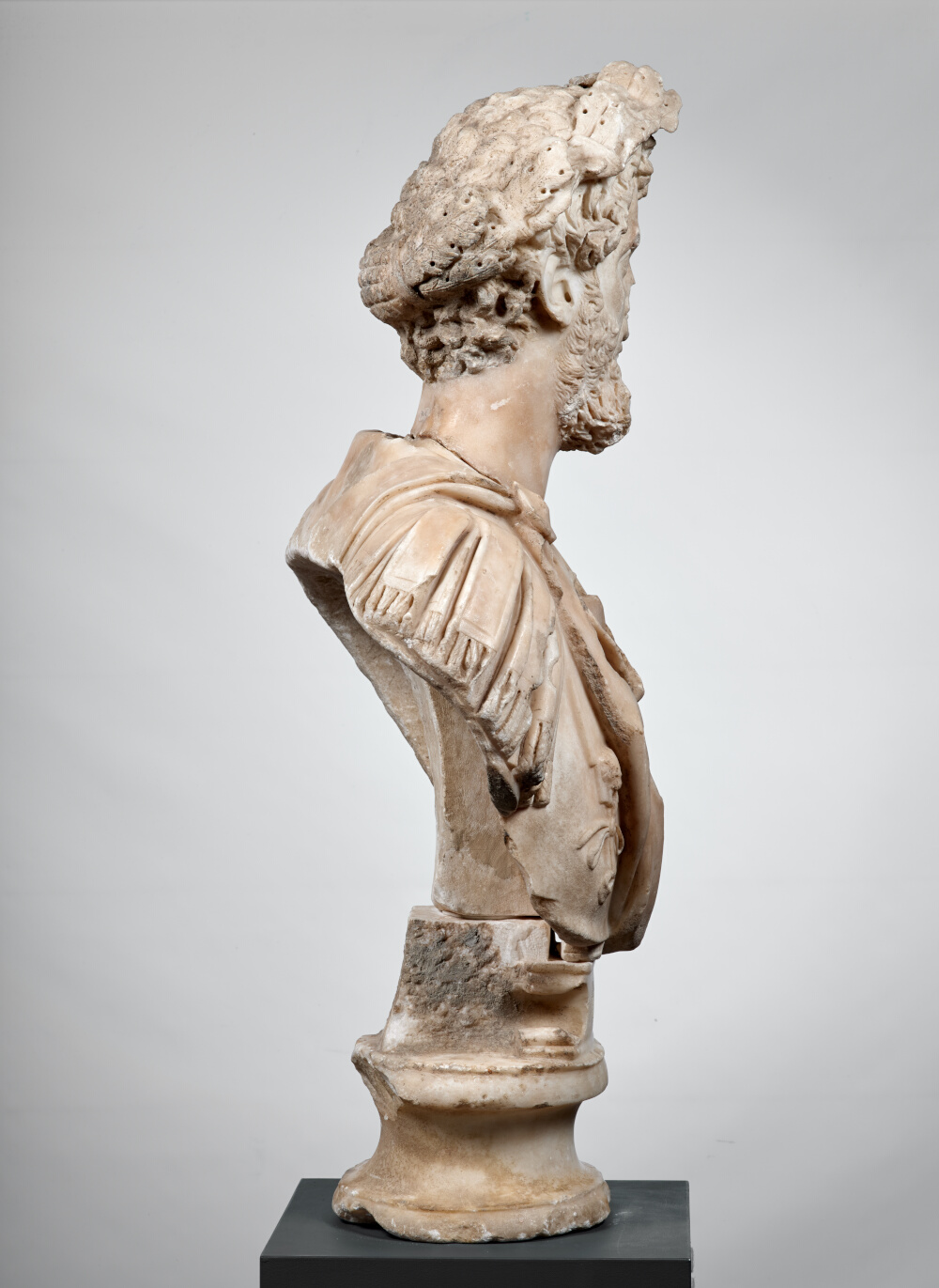
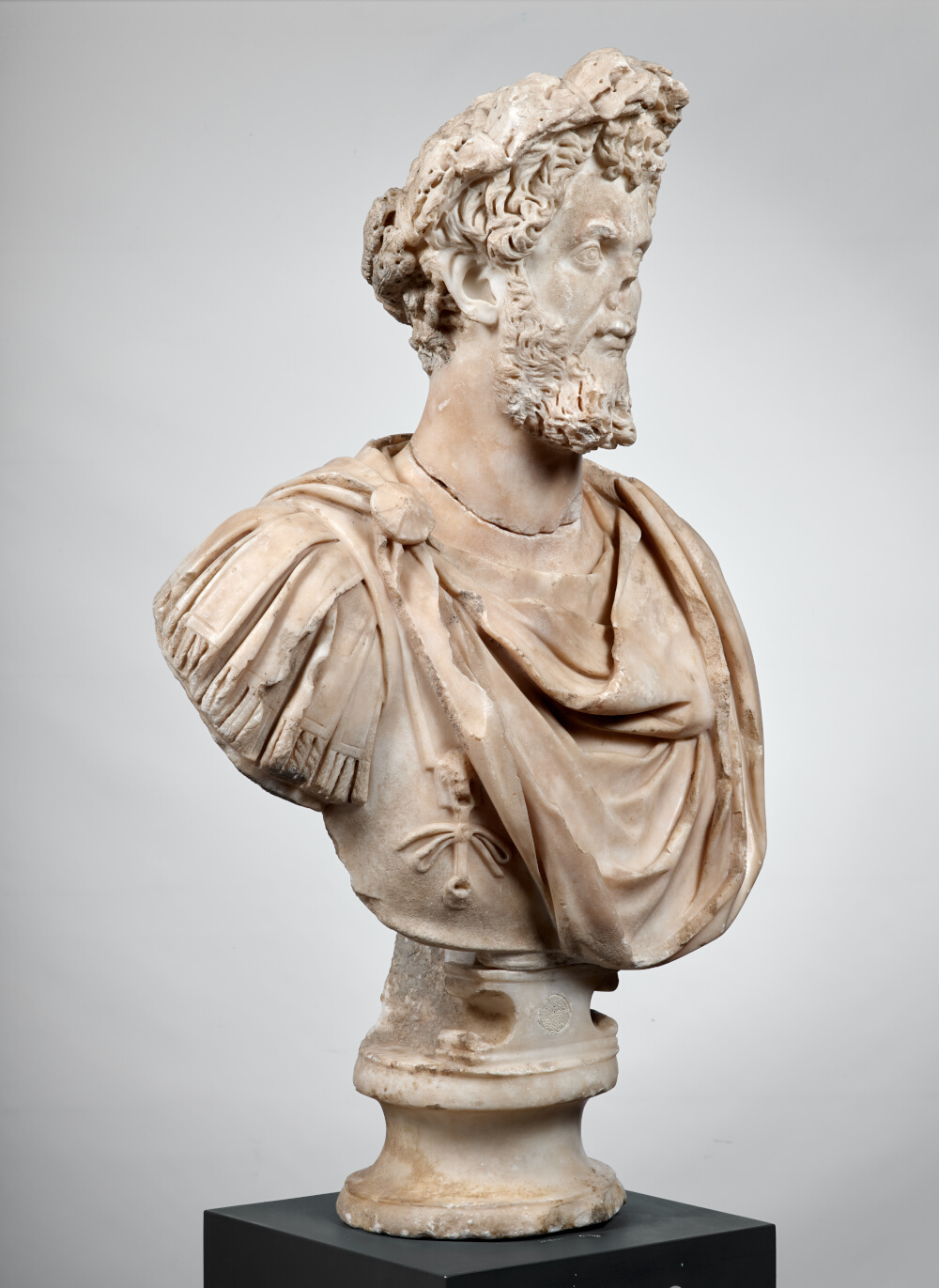
- Biographic data
- 145 - 211
Emperor from 193 to 211 - Date de création
- Between 203 and 211; maybe as early as 199/200
- Type
- of the "Serapis" type
- Material
- Dokimium marble (Turkey)
- Dimensions
- H. 78 x l. 64 x P. 33 (cm)
- Inventory number
- Ra 66 b
- Photo credits
- Daniel Martin
This portrait has been fitted to a bust that originally belonged to a completely different emperor. Marianne Bergmann has noted the lack of proportion between the size of the civic crown (which is unusual, and even rare among statue portraits designed by workshops in Rome) and the face M. Bergmann, « Die kaiserzeitlichen Porträts der Villa von Chiragan:Spätantike Sammlung oder gewachsenes Ensemble?, » Statuen in der Spätantike, Wiesbaden, 2007, pp. 323–340, p. 332.. It is also worth noting the abnormal size of the ears, which, along with the civic crown, belonged to the initial bust. When viewed in profile, this discrepancy is particularly striking, as the front part of the crown clearly protrudes beyond the outline of the face, and the recut is clearly visible along the lower edge of the crown, at the front. The neck is also very thick compared to the overall volume of the head, although in profile, it has been trimmed at the back to remove the protruding part of the cuirass that protects the upper part of the spine.
Several portraits of Antoninus Pius, four to be precise, all created by workshops in Rome, sport the same sort of crown. To the left of the nape of the neck, the two or three superimposed strands combed towards the left that extend a large S-shaped strand of hair (almost centred above the neck) are reminiscent of those seen in portraits of Antoninus. It would therefore seem that a bust of this same emperor was reused for this portrait in Toulouse. This certainly does not mean that the emperor’s image was « reappropriated » after having been « condemned from memory » (damnatio memoriae), but rather that a bust produced in excess during a previous reign almost half a century earlier, and left unused in the reserves of the Roman workshop, was simply recycled. Given the quality of the portrait, and the parallels it suggests, it is highly unlikely that the transformation was made in Gallia Narbonensis. Other portraits of « good emperors », who were therefore not rejected as a result of a damnatio memoriae, apparently suffered the same fate, albeit at a much later date, and for very different reasons. The rapid succession of reigns throughout the 3rd century certainly resulted in portraits being reused when the unexpected proclamation of a new emperor meant that they could not therefore be distributed throughout the various provinces. It remains to be explained, however, why a bust of Antoninus Pius was still lingering in a Roman workshop in the very early years of the 3rd century. It is only by discovering similar analogies that the real answer to this question will emerge.
The type to which this third portrait of Septimius Severus from Chiragan belongs includes the most characteristic and numerous images of the emperor. To date, there are almost 90 known specimens. They are easily recognisable thanks to the four corkscrew locks that fall down onto the forehead, and have been likened to images of the god Serapis, created in Alexandria at the very beginning of the Hellenistic period, and generally attributed to the sculptor Bryaxis. It is therefore known as the « Serapis » type.
There is little doubt that Severus was anxious to portray himself as some sort of god: according to the biographer of the Historia Augusta, after his stay in Alexandria on his return from his Parthian expedition (late 199 - spring 200), Septimius Severus constantly « spoke of the pleasure he derived from this journey, which enabled him to become acquainted with the cult of Serapis, to contemplate ancient monuments, and to see new animals and places » Histoire Auguste, Histoire Auguste, 4th century, v. Sev. 17, 4.. Serapis is a universal cosmocrator, or master of the universe. As the dynastic god of the Lagid rulers, « who guaranteed prosperity during reigns and victory in battles » L.I.M.C., Lexicon Iconographicum Mythologiae Classicae. vol. VII, Zürich ; Munich, 1994, p. 692., he served the same function for certain emperors. Following his trip to the Serapeum of Alexandria, Septimius Severus could not have chosen a better protective divinity, and he had certainly already heard of Serapis. In Leptis Magna, as in his hometown, and in Sabratha, major sanctuaries were devoted to the god of Alexandria, whose cult had extended to the emporia of Tripolitania as early as the Hellenistic period.
With its iconography heralded by the « adoption » type of sculpture that linked Severus to the emperor-philosopher Marcus Aurelius, this « Serapis » type was a decisive step in the representation of the sovereign. In particular, it marked the advent, at the head of the Empire, of men who now originated from the African or Eastern provinces, and their respective gods. Serapis did not replace Jupiter. On the contrary, this merger merely made him twice as powerful. The dual attribute of « master of the universe » and « invincible » fully justified Severus’s assimilation (« Angleichung ») with the god of Alexandria, as he himself had just ousted those vying for the Empire, and now reigned over all the provinces, proud of the harmony he believed now sealed the future of a new dynasty. It should be noted, however, that this assimilation did not make the emperor a god.
In spite of the substantial re-sculpting of the entire face, this portrait is one of the best of all the portraits of the Emperor to have survived. What’s more, it has not been subjected to any form of modern restoration (except for the tip of the nose, since removed, where the smoothed surface to which the prosthesis was attached is still visible).
According to J.-C. Balty 2020, Les Portraits Romains : L’époque des Sévères, Toulouse, p. 106-116.
Bibliography
- Attanasio, Bruno, Prochaska 2019 D. Attanasio, M. Bruno, W. Prochaska, « The Marbles of Roman Portraits: New Data on the Marble Provenance of 261 Imperial and Private Urban Portraits Dating from the Mid 1st Century B.C. to the Early 6th Century A.D., » Jahrbuch des Deutschen Archäologischen Instituts, 134, pp. 167–277.
- Balty, Cazes 2021 J.-C. Balty, D. Cazes, Les portraits romains, 1 : L’époque des Sévères, 1.3 (Sculptures antiques de Chiragan (Martres-Tolosane), Toulouse. p. 12-14, 106-116, fig.3-5
- Balty, Cazes, Rosso 2012 J.-C. Balty, D. Cazes, E. Rosso, Les portraits romains, 1 : Le siècle des Antonins, 1.2 (Sculptures antiques de Chiragan (Martres-Tolosane), Toulouse. p. 43, fig. 41, p. 265, 268, fig. 197, 203
- Bergmann 2007 M. Bergmann, « Die kaiserzeitlichen Porträts der Villa von Chiragan:Spätantike Sammlung oder gewachsenes Ensemble?, » Statuen in der Spätantike, Wiesbaden, pp. 323–340. p. 332
- Bernoulli 1882 J.J. Bernoulli, Römische Ikonographie, Stuttgart. p. 26, no 58
- Braemer 1952 F. Braemer, « Les portraits antiques trouvés à Martres-Tolosane, » Bulletin de la Société Nationale des Antiquaires de France, pp. 143–148. p. 146
- Cazes et al. 1999 D. Cazes, E. Ugaglia, V. Geneviève, L. Mouysset, J.-C. Arramond, Q. Cazes, Le Musée Saint-Raymond : musée des Antiques de Toulouse, Toulouse-Paris. p. 128
- Du Mège 1835 A. Du Mège, Description du musée des Antiques de Toulouse, Toulouse. p. 120, no 213
- Du Mège 1844 A. Du Mège, Description du musée des Antiques de Toulouse (document manuscrit ). no 373
- Espérandieu 1908 É. Espérandieu, Recueil général des bas-reliefs de la Gaule romaine, 2. Aquitaine, Paris. p. 75, no 976
- Joulin 1901 L. Joulin, Les établissements gallo-romains de la plaine de Martres-Tolosane, Paris. p. 337, no 293, pl. XXII
- Massendari 2006 J. Massendari, La Haute-Garonne : hormis le Comminges et Toulouse 31/1 (Carte archéologique de la Gaule), Paris. p. 245, fig. 108
- McCann 1968 A.M. McCann, The Portraits of Septimius Severus (A.D. 193-211) (Memoirs of the American Academy in Rome), Rome. p. 172-173, no 84, pl. LXXVa
- Rachou 1912 H. Rachou, Catalogue des collections de sculpture et d’épigraphie du musée de Toulouse, Toulouse. p. 45, no 66 b
- Raeder 2019 J. Raeder, « Das Bildnis Des C. Fulvius Plautianus Und Andere Durch Umarbeitung Entstandene Bildnisse Des Septimius Severus, » Jahrbuch des Deutschen Archaologischen Instituts, 134, pp. 279–309.
- Roschach 1892 E. Roschach, Catalogue des musées archéologiques de la ville de Toulouse : Musée des Augustins, Musée Saint-Raymond, Toulouse. p. 35, no 66 b
- Roschach 1865 E. Roschach, Catalogue des antiquités et des objets d’art, Toulouse. no 66 b
- Rosso 2006 E. Rosso, L’image de l’empereur en Gaule romaine : portraits et inscriptions (Archéologie et histoire de l’art), Paris. p. 473-474, no 228
- Soechting 1972 D. Soechting, Die Porträts des Septimus Severus (Habelts Dissertationsdrucke. Reihe klassische Archäologie), Bonn. p. 213, no 118
- Histoire Auguste 4th century Histoire Auguste, Histoire Auguste.
- p. 692
- von Heintze 1966 H. von Heintze, « Studien zu den Porträts des 3. Jahrhunderts n. Chr., 7. Caracalla, Geta, Elagabal und Severus Alexander, » Mitteilungen des Deutschen Archäologischen Instituts. Römische Abteilung (MDAIR), 66, 73-74, pp. 190–231. p. 198, no 42, no 2
- Musée Saint-Raymond 2011 Musée Saint-Raymond, L’essentiel des collections (Les guides du MSR), Toulouse. p. 46-47
- Musée Saint-Raymond 1995 Musée Saint-Raymond, Le regard de Rome : portraits romains des musées de Mérida, Toulouse et Tarragona. Exhibition, Mérida, Museo nacional de arte romano ; Toulouse, Musée Saint-Raymond ; Tarragone, Museu nacional arqueològic de Tarragona, 1995, Toulouse. p. 177
To cite this notice
Capus P., "Bust of Septimius Severus wearing a cuirass", in The sculptures of the roman villa of Chiragan, Toulouse, 2019, online <https://villachiragan.saintraymond.toulouse.fr/en/ark:/87276/a_ra_66_b>.